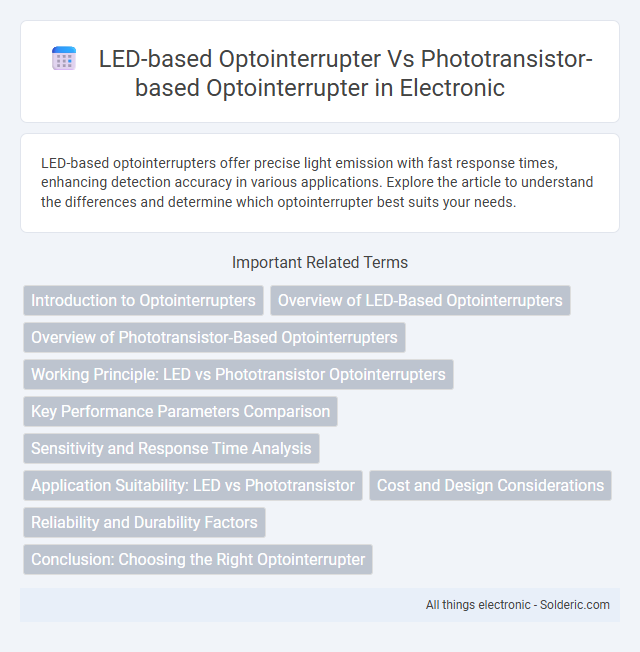LED-based optointerrupters offer precise light emission with fast response times, enhancing detection accuracy in various applications. Explore the article to understand the differences and determine which optointerrupter best suits your needs.
Comparison Table
| Feature | LED-Based Optointerrupter | Phototransistor-Based Optointerrupter |
|---|---|---|
| Light Source | LED (Light Emitting Diode) | LED (External or Integrated) |
| Detector Type | Photodiode or LED sensor | Phototransistor |
| Sensitivity | Moderate, fast response | High sensitivity, slower response |
| Speed (Response Time) | Fast (microseconds) | Slower (milliseconds) |
| Output Signal | Current or Voltage proportional to light | Amplified current (switch-like behavior) |
| Power Consumption | Low | Moderate due to transistor biasing |
| Typical Applications | High-speed optoelectronic switching, position sensing | General motion detection, object presence detection |
| Cost | Moderate | Lower cost |
| Advantages | High speed, linear output | High sensitivity, easy interface |
| Limitations | Complex signal conditioning | Slower response, less linear |
Introduction to Optointerrupters
LED-based optointerrupters use an infrared LED and photodiode pair to detect object presence through interruption of the IR light beam. Phototransistor-based optointerrupters replace the photodiode with a phototransistor, offering higher sensitivity and amplification of the received light signal. Your choice depends on application requirements such as speed, sensitivity, and signal processing complexity, with LED-phototransistor models typically preferred for higher gain and simpler output interfacing.
Overview of LED-Based Optointerrupters
LED-based optointerrupters utilize a light-emitting diode as the light source paired with a photodetector to detect the interruption of the emitted light beam, enabling precise object detection or position sensing. These devices offer high-speed response, low power consumption, and improved reliability compared to traditional phototransistor-based optointerrupters. The emission wavelength and intensity of the LED, combined with the sensitivity of the photodetector, determine overall system performance in applications such as industrial automation and robotics.
Overview of Phototransistor-Based Optointerrupters
Phototransistor-based optointerrupters utilize a phototransistor as the sensing element, which provides high sensitivity to infrared light emitted from an LED source. These devices detect interruptions in the light path, enabling precise object detection and position sensing in automation and robotics. Your choice of a phototransistor-based optointerrupter ensures faster response times and better noise immunity compared to LED-only sensors.
Working Principle: LED vs Phototransistor Optointerrupters
LED-based optointerrupters operate by emitting infrared light from an LED and detecting its interruption by an object, using a photodetector to sense the presence or absence of the light beam. Phototransistor-based optointerrupters function by having a phototransistor that directly converts the received light into an electrical signal, enabling faster and more sensitive detection of light changes. Understanding these working principles helps you choose the right type for applications requiring precise object detection or position sensing.
Key Performance Parameters Comparison
LED-based optointerrupters exhibit faster response times and higher switching speeds compared to phototransistor-based optointerrupters, making them ideal for high-frequency applications. Phototransistor optointerrupters generally provide higher sensitivity and better noise immunity, resulting in improved signal stability under varying ambient light conditions. The choice between the two depends on the specific requirements for speed, sensitivity, and environmental resilience in the target application.
Sensitivity and Response Time Analysis
LED-based optointerrupters generally offer faster response times due to the direct modulation of the light source, enabling rapid switching suitable for high-speed applications. Phototransistor-based optointerrupters exhibit higher sensitivity because phototransistors amplify the detected light signal internally, making them ideal for low-light or long-distance detection scenarios. Your choice between these devices should balance the need for speed against sensitivity requirements based on the specific application's demands.
Application Suitability: LED vs Phototransistor
LED-based optointerrupters provide faster response times and higher sensitivity, making them ideal for high-speed object detection and precision counting applications. Phototransistor-based optointerrupters offer greater durability and higher output current, which suits low-speed position sensing and robust industrial environments. Choosing between them depends on the required speed, sensitivity, and environmental conditions of the application.
Cost and Design Considerations
LED-based optointerrupters generally offer lower cost and simpler design integration due to their compact size and direct LED-photodiode pairing, making them suitable for high-volume applications. Phototransistor-based optointerrupters, while slightly more expensive, provide higher sensitivity and switching speed, which can enhance performance in precision tasks. Your choice depends on balancing budget constraints with required detection accuracy and response time for your specific project.
Reliability and Durability Factors
LED-based optointerrupters typically offer higher reliability due to their solid-state design, which reduces mechanical wear and susceptibility to environmental factors such as dust and vibration. Phototransistor-based optointerrupters, while generally more sensitive to light, can experience degradation over time from prolonged exposure to high-intensity light and temperature variations, impacting durability. The robust encapsulation and inherent stability of LED emitters contribute to longer operational lifespans and better performance consistency under varied operating conditions.
Conclusion: Choosing the Right Optointerrupter
LED-based optointerrupters excel in fast switching speeds and high sensitivity, making them ideal for precision applications such as high-speed object detection and position sensing. Phototransistor-based optointerrupters offer higher gain and better ambient light immunity, suitable for cost-effective and robust detection tasks in variable lighting conditions. Selecting the right optointerrupter depends on balancing speed, sensitivity, and environmental factors specific to the application requirements.
LED-based optointerrupter vs phototransistor-based optointerrupter Infographic

 solderic.com
solderic.com